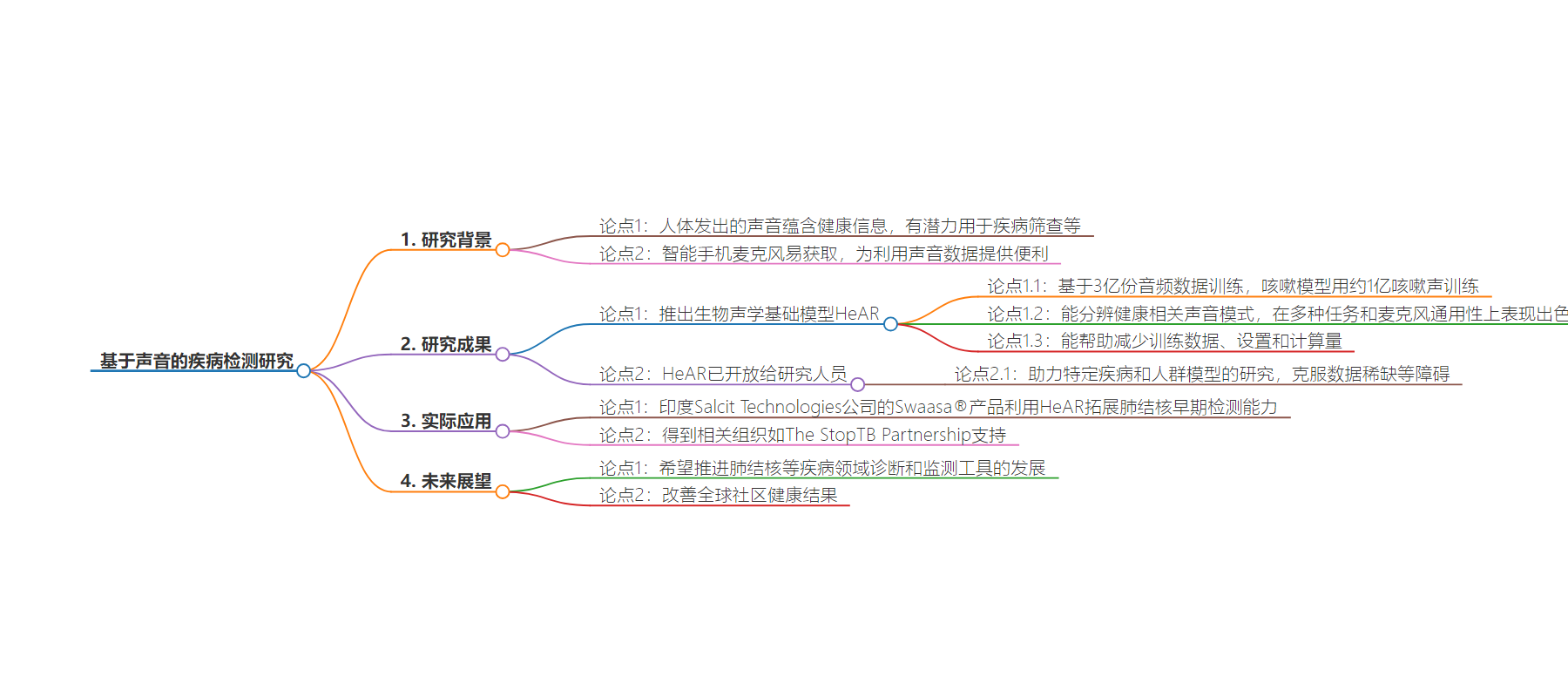包阅导读总结
1. 关键词:AI 模型、疾病检测、咳嗽声音、Health Acoustic Representations、结核病
2. 总结:研究者建立了基于咳嗽等声音检测疾病的 AI 模型,如 HeAR。它在音频数据处理上表现出色,有助于医疗音频分析,印度公司用其研究结核病早期检测,该模型有望改善全球疾病诊断和健康监测。
3. 主要内容:
– 声音蕴含健康信息,谷歌研究者认识到其潜力并探索用 AI 从声学数据中提取健康见解
– 今年推出生物声学基础模型 HeAR,在 3 亿音频数据上训练,在多种任务和麦克风上表现优越
– 能帮助医疗研究在数据少的情况下训练高效模型
– 印度 Salcit Technologies 公司的 Swaasa®产品用 AI 分析咳嗽声评估肺健康,正探索用 HeAR 增强结核病早期检测
– 结核病每年大量病例未诊断,改进诊断至关重要
– 该公司过往在疾病检测有成果,现借助 HeAR 有望在印度扩大结核病筛查
– 包括联合国组织在内对该方法表示支持,HeAR 是声学健康研究的重要一步,有望改善全球健康
思维导图:
文章地址:https://blog.google/technology/health/ai-model-cough-disease-detection/
文章来源:blog.google
作者:Shravya Shetty
发布时间:2024/8/19 17:00
语言:英文
总字数:626字
预计阅读时间:3分钟
评分:89分
标签:医疗保健中的 AI,生物声学分析,疾病检测,HeAR 模型,呼吸健康
以下为原文内容
本内容来源于用户推荐转载,旨在分享知识与观点,如有侵权请联系删除 联系邮箱 media@ilingban.com
From cough to speech and even breath, the sounds our bodies make are filled with information about our health. Subtle clues hidden within these bioacoustic sounds hold the potential to revolutionize how we screen, diagnose, monitor and manage a wide range of health conditions like tuberculosis (TB) or chronic obstructive pulmonary disease (COPD). As researchers at Google, we recognize the potential of sound as a useful health signal, and also that smartphone microphones are widely accessible. To that end, we’ve been exploring ways to use AI to extract health insights from acoustic data.
Earlier this year, we introduced Health Acoustic Representations, or HeAR, a bioacoustic foundation model designed to help researchers build models that can listen to human sounds and flag early signs of disease. The Google Research team trained HeAR on 300 million pieces of audio data curated from a diverse and de-identified dataset, and we trained the cough model in particular using roughly 100 million cough sounds.
HeAR learns to discern patterns within health-related sounds, creating a powerful foundation for medical audio analysis. We found that, on average, HeAR ranks higher than other models on a wide range of tasks and for generalizing across microphones, demonstrating its superior ability to capture meaningful patterns in health-related acoustic data. Models trained using HeAR also achieved high performance with less training data, a crucial factor in the often data-scarce world of healthcare research.
HeAR is now available to researchers to help accelerate development of custom bioacoustic models with less data, setup and computation. Our goal is to enable further research into models for specific conditions and populations, even if data is sparse or if cost or compute barriers exist.
Salcit Technologies, an India-based respiratory healthcare company, has built a product called Swaasa® that uses AI to analyze cough sounds and assess lung health. Now, the company is exploring how HeAR can help expand the capabilities of their bioacoustic AI models. To start, Swaasa® is using HeAR to help research and enhance their early detection of TB based on cough sounds.
TB is a treatable disease, but every year millions of cases go undiagnosed — often because people don’t have convenient access to healthcare services. Improving diagnosis is critical to eradicating TB, and AI can play an important role in improving detection and helping make care more accessible and affordable for people around the world. Swaasa® has a history of using machine learning to help detect diseases early, bridging the gap with accessibility, affordability and scalability by offering location-independent, equipment-free respiratory health assessment. With HeAR, they see an opportunity to extend screening for TB more widely across India by building on this research.
“Every missed case of tuberculosis is a tragedy; every late diagnosis, a heartbreak,” says Sujay Kakarmath, a product manager at Google Research working on HeAR. “Acoustic biomarkers offer the potential to rewrite this narrative. I am deeply grateful for the role HeAR can play in this transformative journey.”
We’re also seeing support for this approach from organizations including The StopTB Partnership, a United Nations-hosted organization that brings together TB experts and affected communities with the goal of ending TB by 2030.
“Solutions like HeAR will enable AI-powered acoustic analysis to break new ground in tuberculosis screening and detection, offering a potentially low-impact, accessible tool to those who need it most,” said Zhi Zhen Qin, digital health specialist with the Stop TB Partnership.
HeAR represents a significant step forward in acoustic health research. We hope to advance the development of future diagnostic tools and monitoring solutions in TB, chest, lung and other disease areas, and help improve health outcomes for communities around the globe through our research. If you’re a researcher interested in exploring HeAR, you can learn more and request access to the HeAR API.
